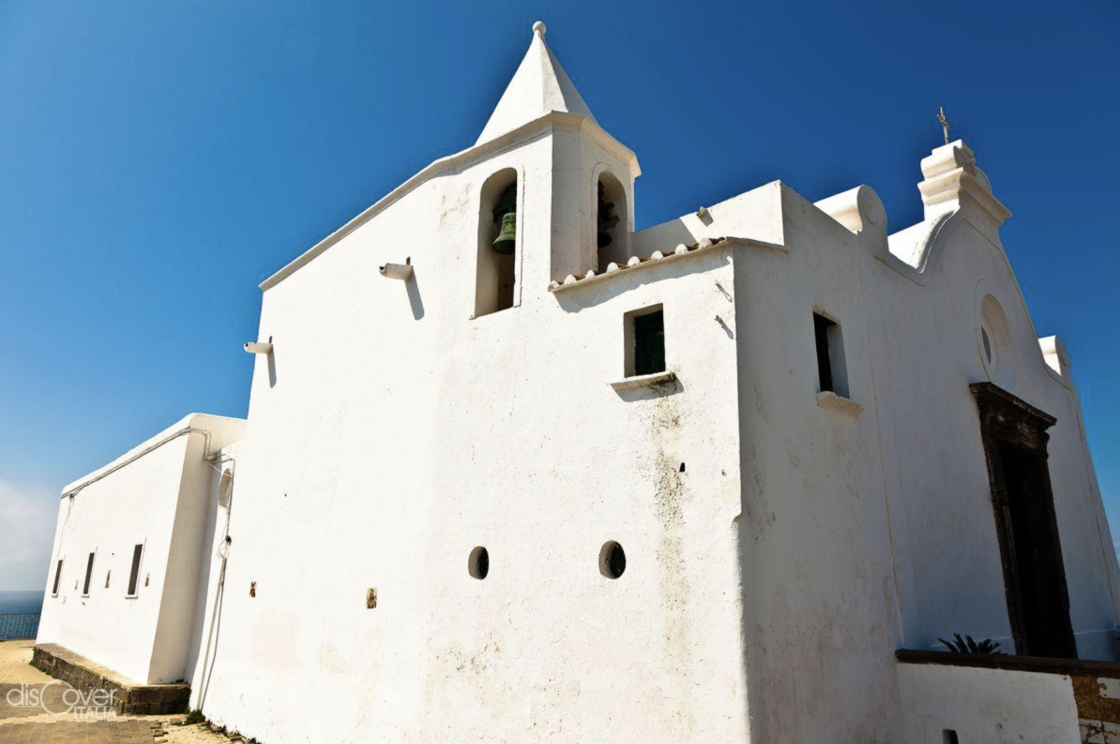With the possibility of enjoying, on certain days, the rare vision of the Green Ray. A place also made unique by the church of Santa Maria della Neve, a candid accent in the immensity of the blue sky. It is a church without equal, that of Soccorso. With simple, essential lines, accentuated by the whiteness that characterizes it. Without a preponderant style, but a synthesis of various styles, linked to the many alterations it has undergone over the centuries, which identify it as a "Mediterranean" building, in total harmony with the sea and the sky. It is accessed by a spectacular double ramp staircase, decorated with sacred scenes in polychrome majolica and five wooden crosses. The piperno portal leads into the nave onto which the few chapels open with works that bear witness to the long-standing membership of the Augustinian order and the profound devotion of seafarers. And in fact, on the decorative band that runs along the walls, there are various ancient models of sailing ships, ex voto of sailors.
There is no shortage of valuable works. There is the Madonna of the scourges, exhibited in the transept; in the chapel dedicated to him, the venerated sixteenth-century wooden Crucifix stands out. According to legend, it was deposited by the stormy sea on the rocks below the promontory. A sculpture to which a miraculous power has been attributed over the centuries, known throughout the island. To crown the Crucifix, in contrast to its drama, a delicate, refined decoration of fifteen papier-mâché cherubs, recently restored. Of great value are the two marble medallions from the 15th century, which depict Santo Stefano and San Giovanni Battista, part of a triptych from the Assante family mausoleum, which was once in the Annunziata church on the Aragonese Castle. The central medallion with the bas-relief of the Madonna del Granato is incorporated into the altar of the church of the Archinconfraternity of Santa Maria di Costantinopoli in Ischia Ponte.
To the right are two other chapels. In one is kept a painting with St. Augustine, St. Monica and St. Nicholas of Tolentino, all Augustinian saints depicted in 1633 by the Forian painter Cesare Calise. There was also a triptych dedicated to St. Anthony of which only the lower register remains in the sacristy in which the figures of four Forian women in traditional dress can be distinguished. The names are also reported there.
It is an ancient church. Existing even before entering, with the surrounding land, in the patrimony of the Augustinians, who had already settled in Ischia and who in the fourteenth century had built the great church of Santa Maria della Scala in the current Ischia Ponte. In their phase of expansion on the island, favored by the conspicuous bequests of many noble and rich faithful, the Augustinians, deeply rooted in Ischia, had invested in the church of Forio, equipping it with a small convent with just six cells and accompanied by a large garden, protected by a wall from the brackish winds. However, according to a document from the mid-14th century, the church dated back to three centuries earlier and would have remained in the Augustinian possession until 1653, when it became part of the patrimony of the University (today Municipality) of Forio. Subsequently, the sacred building was the subject of various renovations, the last of which added Baroque elements to the Gothic and Renaissance ones, already present and clearly visible. A large dome was also built, which did not survive the earthquake of 1883. While the small bell tower remained standing. It overlooks the natural terrace from which you can admire the horizon. And the fiery sunset that greets the night.





